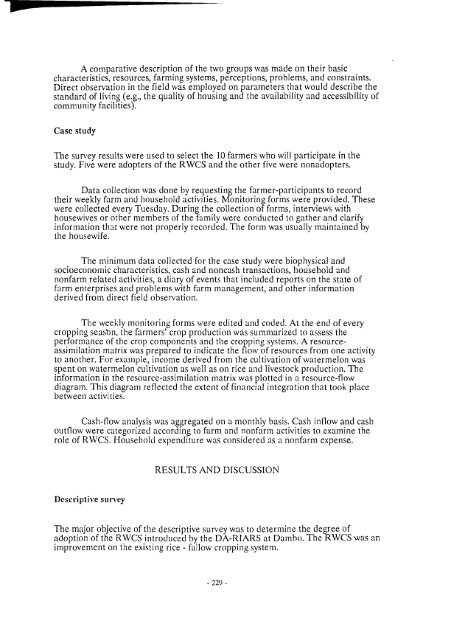systems research - the IDRC Digital Library - International ...
systems research - the IDRC Digital Library - International ...
systems research - the IDRC Digital Library - International ...
Create successful ePaper yourself
Turn your PDF publications into a flip-book with our unique Google optimized e-Paper software.
A comparative description of <strong>the</strong> two groups was made on <strong>the</strong>ir basic<br />
characteristics, resources, farming <strong>systems</strong>, perceptions, problems, and constraints.<br />
Direct observation in <strong>the</strong> field was employed on parameters that would describe <strong>the</strong><br />
standard of living (e.g., <strong>the</strong> quality of housing and <strong>the</strong> availability and accessibility of<br />
community facilities).<br />
Case study<br />
The sunrey results were used to select <strong>the</strong> 10 farmers who will participate in <strong>the</strong><br />
study. Five were adopters of <strong>the</strong> RWCS and <strong>the</strong> o<strong>the</strong>r five were nonadopters.<br />
Data collection was done by requesting <strong>the</strong> farmer-participants to record<br />
<strong>the</strong>ir weekly farm and household activities. Monitoring forms were provided. These<br />
were collected every Tuesday. During <strong>the</strong> collection of forms, interviews with<br />
housewives or o<strong>the</strong>r members of <strong>the</strong> family were conducted to ga<strong>the</strong>r and clarify<br />
information that were not properly recorded. The form was usually maintained by<br />
<strong>the</strong> housewife.<br />
The minimum data collected for <strong>the</strong> case study were biophysical and<br />
socioecono~nic characteristics, cash and noncash transactions, household and<br />
nonfarm related activities, a diary of events that included reports on <strong>the</strong> state of<br />
farm enterprises and problems with farm management, and o<strong>the</strong>r information<br />
derived from direct field observation.<br />
The weekly monitoring forms were edited and coded. At <strong>the</strong> end of every<br />
cropping seasbn, <strong>the</strong> farmers' crop production was summarized to assess <strong>the</strong><br />
performance of <strong>the</strong> crop components and <strong>the</strong> cro ping <strong>systems</strong>. A resourceassimilation<br />
matrix was prepared to indicate <strong>the</strong> 1 ow of resources from one activity<br />
to ano<strong>the</strong>r. For exa~nple, income derived from <strong>the</strong> cultivation of watermelon was<br />
spent on watermelon cultivation as well as on rice and livestock production. The<br />
information in <strong>the</strong> resource-assimilation matrix was plotted in a resource-flow<br />
diagram. This diagram reflected <strong>the</strong> extent of financial integration that took place<br />
between activities.<br />
Cash-flow analysis was aggregated on a monthly basis. Cash inflow and cash<br />
outflow were categorized according to farm and nonfarm activities to examine <strong>the</strong><br />
role of RWCS. Household expenditure was considered as a nonfarm expense.<br />
Descriptive survey<br />
RESULTS AND DISCUSSION<br />
The major objective of <strong>the</strong> descriptive survey was to determine <strong>the</strong> degree of<br />
adoption of <strong>the</strong> RWCS introduced by <strong>the</strong> DA-RIARS at Dambo. The RWCS was an<br />
improvement on <strong>the</strong> existing rice - fallow cropping system.
















